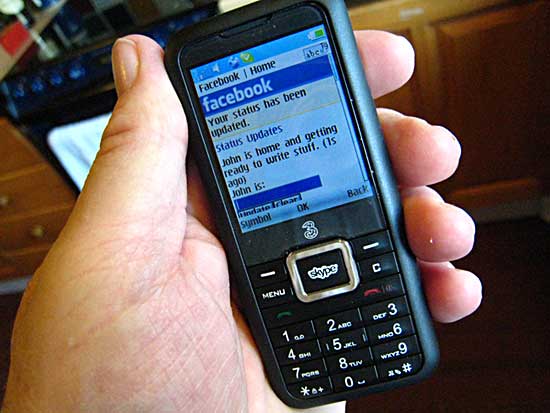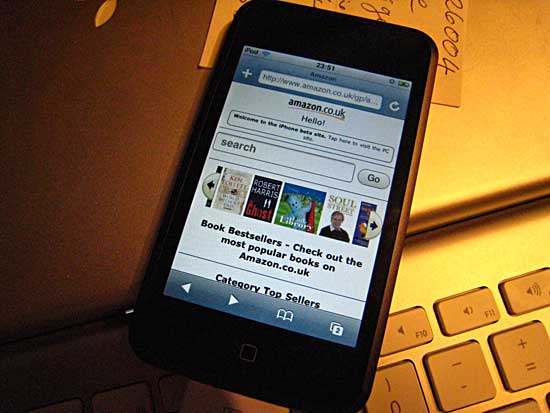Michael’s got some new kit — including an amazing keyboard.
Category Archives: Technology
Well, I’ll be Skyped…

My Skype phone arrived today, and it’s a very interesting gadget indeed. It’s got a lovely implementation of Skype and does Skype-to-Skype calls smoothly — and free. Also the Skype IM client works smoothly and efficiently. It’s also a perfectly good ‘ordinary’ phone (and has quite a decent 2MP camera) with Bluetooth and a micro SD card. What with this and the iPhone and the revelations about Google phone plans, the mobile phone business is about to become a LOT more interesting than it has been up to now.
Haven’t read all the small print yet, so haven’t been able to check what happens when you want to make Skype-to-Skype calls in another country. There has to be a downside to this somewhere. But it’s a neat and innovative package just for UK use.
Oh — I almost forgot — it’s also got a nice app which makes it easy to post Facebook status updates. See photograph.
Everyday miracles
Quentin has a lovely meditation on technological miracles that we take for granted.
The Lifestraw

Picture credit: Vestergaard Frandsen
From Photos: Low-cost tech that meets basic needs | CNET News.com…
People can safely drink from polluted bodies of water through the go-anywhere LifeStraw, which filters more than 99 percent of life-threatening bacteria and viruses. It costs up to $5 and lasts about a year, filtering 2 liters per day. A quarter of a million LifeStraws are in use throughout Asia and Africa, where nonprofit groups distribute them following emergencies, such as this month’s monsoon floods in India.
LifeStraw maker Vestergaard Frandsen is working to develop water filters to shut out toxic chemicals, such as arsenic found commonly in Bangladesh. Its new household filter can handle 15 times the amount of water as the straw. The Swiss company spent millions of dollars over a decade to develop the LifeStraw, which grew out of the nonprofit Carter Center’s goal to eradicate the Guinea worm disease. The prevalence of this ailment, caused by a water-borne parasite prevalent in western Africa, has shrunk to less than 100,000 cases from 50 million in the 1950s.
Neat, eh?
The future of computing (contd.)

As Quentin says, who would have thought ten years ago that Unix machines would look like this? The most interesting thing about the iPod Touch is not that it’s a music player, but that it’s the best portable browsing machine we have yet seen. Its capacity to render web pages and make them readable is simply astounding. The touch interface plus the software’s rendering ability also suggests that the newspaper industry has been looking in the wrong place all the time. It always supposed that its electronic salvation lay in display hardware — in the form of ‘e-paper’, i.e. lightweight foldable, flexible, high-resolution displays. The effectiveness of the iPod Touch suggests that the combination of clever software and even a small high-res display can do the trick.
The Telco Soviets
Lovely WSJ column by Walt Mossberg…
Suppose you own a Dell computer, and you decide to replace it with a Sony. You don’t have to get the permission of your Internet service provider to do so, or even tell the provider about it. You can just pack up the old machine and set up the new one.
Now, suppose your new computer came with a particular Web browser or online music service, but you’d prefer a different one. You can just download and install the new software, and uninstall the old one. You can sign up for a new music service and cancel the old one. And, once again, you don’t need to even notify your Internet provider, let alone seek its permission.
Oh, and the developers of such computers, software and services can offer you their products directly, without going through the Internet provider, without getting the provider’s approval, and without giving the provider a penny. The Internet provider gets paid simply for its contribution to the mix: providing your Internet connection. But, for all practical purposes, it doesn’t control what is connected to the network, or carried over the network.
This is, he says “the way digital capitalism should work”, and he’s right. But there’s one area in digital technology where it doesn’t apply — the mobile phone industry.
A shortsighted and often just plain stupid federal government has allowed itself to be bullied and fooled by a handful of big wireless phone operators for decades now. And the result has been a mobile phone system that is the direct opposite of the PC model. It severely limits consumer choice, stifles innovation, crushes entrepreneurship, and has made the U.S. the laughingstock of the mobile-technology world, just as the cellphone is morphing into a powerful hand-held computer.
Whether you are a consumer, a hardware maker, a software developer or a provider of cool new services, it’s hard to make a move in the American cellphone world without the permission of the companies that own the pipes. While power in other technology sectors flows to consumers and nimble entrepreneurs, in the cellphone arena it remains squarely in the hands of the giant carriers.
The Soviet Ministry Model
That’s why I refer to the big cellphone carriers as the “Soviet ministries.”
It goes on, and gets even better. This is a great op-ed piece.
Time Out Pad
Yuck. Google threw up this ad in a Gmail message about the pressures that kids are under nowadays. The blurb reads, in part:
Young children need to learn when their behaviour isn’t acceptable. To do this, many parents use the time-out or naughty step technique, making the child sit quietly (usually on the bottom step of the stairs) for a few minutes to calm down and reflect on their actions.
In practice it’s not always easy. How do you time a time-out, when you’ve got so many things to do? And what happens if the child gets off the naughty step during the time-out? How does the child know when the time-out is finished?
Time Out Pad ensures effective time-outs and encourages better child behaviour.
Key Features
* Simple to use pressure pad with built-in timer, helps parents monitor time-outs
* Adjustable timer from 1-5 minutes
* Visual countdown and audio function
* Includes free ‘Positive Parenting’ guide
* Suitable for children from 2 years upwardsHow the Time Out Pad works
Simply set the built-in timer to the desired time-out duration (usually one minute per year of the child’s age) and sit the child on the pressure sensitive pad.If the child gets up before the end of the programmed time, an alarm sounds to alert the parent or carer, and the countdown will pause until the child sits back down.
Presumably the Premium version gives the kid a mild electric shock if s/he moves.
The future of personal computing
According to Nicholas Carr, it’s captured in a single simple equation: Google plus Apple.
The future of personal computing was divulged by Mr. Eric Schmidt, the chief executive officer of Google, on March 23 of this year during an interview with Wired’s Fred Vogelstein. Vogelstein asked Schmidt why he had recently joined Apple’s board of directors, and Schmidt responded:
“Google’s architectural model around broadband and services and so forth plays very well to the powerful devices and services Apple is doing. We’re a perfect back end to the problems that they’re trying to solve. And they have very good judgment on user interface and people. They don’t have this supercomputer I’m talking about, which is the data centers.”
At this very moment, in a building somewhere in Silicon Valley, I guarantee you that a team of engineers from Google and Apple are designing a set of devices that, hooked up as terminals to Google’s “supercomputer,” will define how we use computers in the future. You can see various threads of this system today – in Apple’s iPhone and iPod Touch, its dot-mac service, its iLife and iWork applications as well as in Google’s Apps suite and advertising system, not to mention its vast data-center network. What this team is doing right now is weaving all those threads together into what will be, for most of us, the fabric of cloud computing. (This is so big, you need at least two metaphors to describe it.)
Damn. I’m going to have to get an iPhone…
TrueGrain
This is interesting to anyone who — like me — muses on the aesthetic differences between digital and analogue photography.
TrueGrain is a creative tool for accurately recapturing the aesthetics of black and white film with digital imagery.
TrueGrain takes the form of a stand-alone image processing utility that imposes the physical characteristics of a real-world film stock onto a digital image. The synthesis is done through measured and sampled data gathered from the actual film and development process being reproduced…
Here’s the workflow:
1. Prepare a color digital photograph as a TIF file
2. Load the TIF file into TrueGrain
3. Choose a film stock
4. Save the resulting image
It’s ingenious, but expensive. A single licence costs $300. Having just taken delivery of a batch of chemicals for processing some recent films, I’ll stick with chemistry for the time being.
There’s a nice irony in using sophisticated digital processing techniques to create an analogue effect!
Many thanks to Boyd Harris for spotting it.
Neat work, AP
Associated Press have done a really neat piece of detective work to investigate rumours of dirty tricks by Comcast, a US ISP.
NEW YORK (AP) – To test claims by users that Comcast Corp. was blocking some forms of file-sharing traffic, The Associated Press went to the Bible.
An AP reporter attempted to download, using file-sharing program BitTorrent, a copy of the King James Bible from two computers in the Philadelphia and San Francisco areas, both of which were connected to the Internet through Comcast cable modems.
We picked the Bible for the test because it’s not protected by copyright and the file is a convenient size.
In two out of three tries, the transfer was blocked. In the third, the transfer started only after a 10-minute delay. When we tried to upload files that were in demand by a wider number of BitTorrent users, those connections were also blocked.
Not all Comcast-connected computers appear to be affected, however. In a test with a third Comcast-connected computer in the Boston area, we were unable to test with the Bible, apparently due to an unrelated error. When we attempted to upload a more widely disseminated file, there was no evidence of blocking.
The Bible test was conducted with three other Internet connections. One was provided by Time Warner Inc.’s Time Warner Cable, and the other came from Cablevision Systems Corp. The third was the business-class connection to the AP’s headquarters, provided by AT&T Inc. and Cogent Communications Group Inc.
No signs of interference with file-sharing were detected in those tests.
Further analysis of the transfer attempt from the Comcast-connected computer in the San Francisco area revealed that the failure was due to ”reset” packets that the two computers received, carrying the return address of the other computer.
Those packets tell the receiving computer to stop communicating with the sender. However, the traffic analyzer software running on each computer showed that neither computer actually sent the packets. That means they originated somewhere in between, with faked return addresses…
It seems that Comcast uses Sandvine traffic-shaping hardware to limit the effectiveness of BitTorrent seeding. The goal is to manage BitTorrent traffic without tipping off mainstream users that it’s being done. This source cites Robb Topolski’s explanation of how it’s achieved:
“The Sandvine application reads packets that are traversing the network boundary. If the application senses that outbound P2P traffic is higher than a threshold determined by Comcast, Sandvine begins to interrupt P2P protocol sequences that would initiate a new transfer from within the Comcast network to a peer outside of the Comcast network. The interruption is accomplished by sending a perfectly forged TCP packet (correct peer, port, and sequence numbering) with the RST (reset) flag set. This packet is obeyed by the network stack or operating system which drops the connection.”
I love the idea of using the Bible as the test file. Reminds me of Larry Lessig’s report of coming into his office in Stanford one morning to find the network police waiting for him, grimly announcing that it had been discovered that he had P2P software installed on his computer. Larry explained that he used P2P as a way of distributing his own publications — intellectual property that he owned. The idea that there might be legitimate uses for P2P had clearly never occurred to the management.
And that’s in Stanford!
Later: Ed Felten has also commented on Comcast’s traffic shaping practices.
